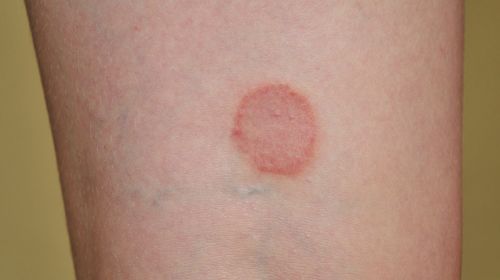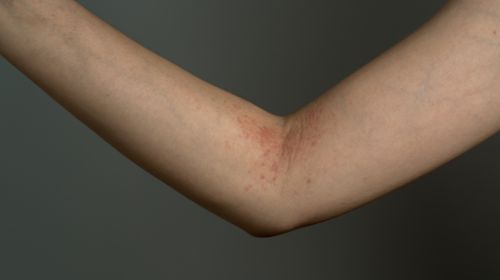Seborrheic dermatitis is a common, inflammatory-scaly disease of the skin. Is seborrheic eczema contagious? How is it different from other skin diseases? And what really helps against it?
- Seborrheic dermatitis often occurs on the scalp and face.
- © iStock.com/russaquarius
Overview of article content
What is seborrheic eczema?
Seborrheic dermatitis, also called seborrheic dermatitis, is a non-contagious skin disease that manifests itself as red foci of inflammation with yellowish-oily scales. It occurs in different degrees of severity and predominantly on the scalp and face (nasolabial folds, forehead, eyebrows), but can also spread to other areas of the body with high sebum production such as the sternum, back, armpits, groin or genital area.
The disease is harmless, but many sufferers find it very stressful. It is estimated that between three and ten percent of the population in Europe suffer from seborrheic dermatitis.
There are two types of skin disease:
- Seborrheic dermatitis in adolescents and adults (type I): Often occurs for the first time during puberty or between the third and sixth decade of life, requires treatment and is usually chronic or chronic recurring. Men are affected slightly more often than women.
- Seborrheic dermatitis in infants (type II): In the first months of life, about three to five percent of all infants suffer from it. Eczema primarily affects the scalp and forehead, as well as isolated skin folds, body bends and the diaper area, manifests itself in greasy, flaky scales and usually heals permanently even without treatment. Colloquially, seborrheic eczema in infants is called (head) gneiss. The commonly used term cradle cap is incorrect because cradle cap can indicate the onset of neurodermatitis in children.
How does seborrheic eczema develop?
The exact causes of seborrheic eczema have not yet been fully researched. Experts believe that various factors must come together for the onset of the disease. These include, for example, (genetically determined) overproduction of the sebum glands and the excessive colonization of the skin with certain fungi, the Malassezia skin fungi. As with other eczemas, the hair follicles become inflamed, which interferes with the process of skin renewal and more skin particles (dandruff) are rejected. An increased bacterial infestation (staphylococci) of the affected skin areas is also frequently observed.
Other risk factors for seborrheic dermatitis in adolescence and adulthood (type I) include:
- Weakened immune system: If there is an HIV infection, the likelihood of illness increases to 30 to 80 percent, and in this case particularly pronounced and difficult to treat forms of seborrheic eczema are often diagnosed.
- Hormonal imbalance: The first occurrence of seborrheic eczema often falls into puberty or (in women) into menopause.
- Neurological impairments: People who have Parkinson’s or other nervous disorders or have had a stroke are more prone to seborrheic eczema.
- Stress: Many sufferers observe an intensification of symptoms in particularly stressful phases of life.
- Certain medications: Anti-cancer cytostatics such as Erlotinib, Sorafenib or Interleukin-2, but also neuroleptics used against various psychiatric disorders can trigger the eczema.
- Climatic factors: Seborrheic eczema often worsens in wet and cold weather, but symptoms usually improve in the summer months.
The trigger for seborrheic eczema in the first months of life (type II) is suspected to be an overproduction of sebum due to residues of maternal hormones that are still in the baby’s blood and are broken down over time.
How can you recognize seborrheic eczema?
In contrast to most other inflammatory skin diseases, seborrheic dermatitis usually causes little or no itching. Sometimes the inflammation and the affected areas of the skin with fungi or bacteria lead to increased hair loss or eczema is accompanied by a partial loss of skin pigments.
Type I symptoms
The inflammation of the hair follicles typically leads to blotchy red skin areas that secrete yellowish-oily scales. If the seborrheic eczema is weak or precursory, only increased scaling can occur. How much skin is affected is individual: In severe cases, severe inflammation occurs in several areas at the same time. Eczema can cause oozing and crusting skin defects.
Type II symptoms
Seborrheic eczema in infants in most cases only affects the head (head gneiss) and is visible there through thick, yellow-greasy scales. The point of origin of the inflammation is usually the apex area. In contrast to other eczema such as neurodermatitis (atopic eczema), the gneiss does not itch and hurt.
How is seborrheic eczema diagnosed?
The correct contact for suspected seborrheic eczema type I is the dermatologist. As part of the medical history, he asks, among other things, how long the symptoms have lasted, whether the eczema is itchy or painful, whether there have been similar illnesses in the past or in the family, and whether there are other illnesses, certain eating habits or medication that are associated with the Skin problems. The specialist then examines the affected areas of the body.
Since many other skin diseases, such as
- Neurodermatitis
- psoriasis
- allergic / toxic contact eczema
- Rose lichen
- Rosacea
- Impetigo contagiosa and
- ringworm
have a similar appearance to seborrheic eczema, a thorough demarcation (differential diagnosis) is necessary.
If in doubt, analysis of a small skin sample (histological examination) can provide clarity. Microscopic detection of skin fungi or excessive bacterial infestation can also provide information about the present disease. Allergic contact eczema can be excluded by an allergy test.
In infancy, for example, diaper thrush or cradle cap can express similarly to seborrheic eczema.
What helps against seborrheic eczema?
Type I treatment
If there is an acute onset of illness, the focus is on alleviating inflammation and reducing the number of fungi and bacteria. The dermatologist prescribes ointments, creams or gels with active ingredients such as ciclopirox, ketoconazole, clotrimazole or metronidazole. Shampoos that contain tar, selenium disulfide or zinc pyrithione can also reduce the number of harmful microorganisms. In severe cases it may be necessary to take certain antibiotics, antifungals or cortisone preparations.
If the impairment is very high, so-called calcineurin inhibitors can also be used temporarily, which have anti-inflammatory and immune-suppressing effects.
Preparations with salicylic acid and urea (urea) have proven useful against pronounced dandruff formation; Excess sebum production is regulated, for example, by the active ingredient isotretinoin. Since UV light usually improves the symptoms, some dermatologists also prescribe phototherapy for severe seborrheic eczema.
Maintenance therapy is the (important) treatment between two attacks of eczema. It usually consists of the use of shampoos and creams with dandruff active ingredients (keratolytics).
Many people with mild seborrheic eczema have good experiences with various home remedies after consulting their dermatologist:
Type II treatment
Gneiss in babies usually heals without treatment, but the unsightly dandruff on the scalp can be gently removed. According to a small comparative study, a special oil gel (oleogel) is more suitable than the frequently recommended olive or almond oil.
Low-dose zinc ointments dry out oozing areas in skin folds or body bends and help against corresponding inflammation in the diaper area.
If a fungal infection of the baby skin is added, the doctor prescribes ointments with active ingredients such as nystatin, clotrimazole or fusidic acid. In the case of very severe inflammation, creams with weak glucocorticoids (cortisone) can also be useful for a short time.
Is seborrheic eczema curable?
While type II usually heals on its own and permanently after a few months, type I is considered incurable – especially because the underlying increased sebum production is genetically determined. With the right therapy, seborrheic eczema can be successfully contained.
In the winter months and when there is a high level of stress, the symptoms often intensify. On the other hand, a summery-maritime climate is considered positive, under the influence of which many affected people temporarily observe a complete healing of the eczema.
If type I seborrheic eczema is left untreated, the condition of the skin may deteriorate further. Rarely, seborrheic eczema can develop into psoriasis.
How can you prevent seborrheic dermatitis?
Since eczema is usually based on genetic factors, preventive measures cannot prevent it, but it can be reduced if necessary.
Öneririz:
- düzenli saç yıkama
- iyi kafa derisi havalandırma (kısa saç kesimi, moda şapka kaçınarak)
- düzenli, nazik cilt temizliği
- zengin, yağlı kozmetiklerden kaçınmak
- cildi tahriş edici maddelerle (parfümler, renkler ve koruyucular) bakım ürünleri ve kozmetiklerin olmaması
- hipoalerjenik, nemlendirici ajanların kullanımı
- güneşin orta düzeyde kullanımı / iyi hipoalerjenik güneş koruması
- cilt sarılma giysilerin en az 60 derecede iyice temizlenmesi
- dengeli, besin açısından zengin bir diyet
- düzenli egzersiz (spor)


